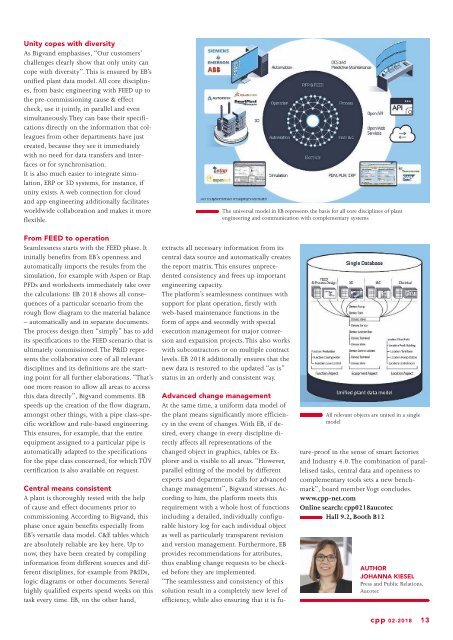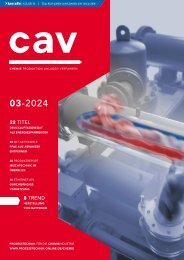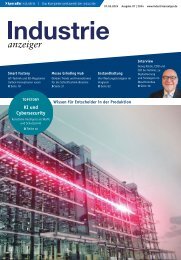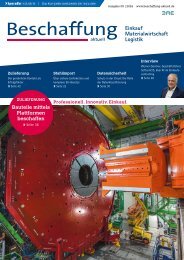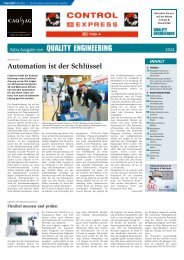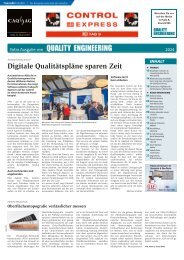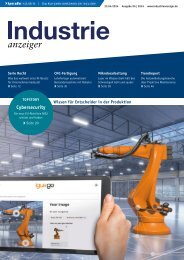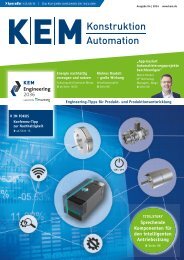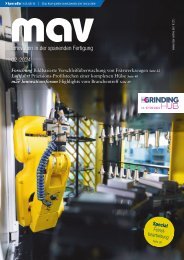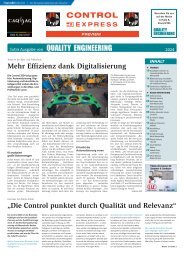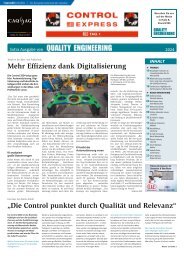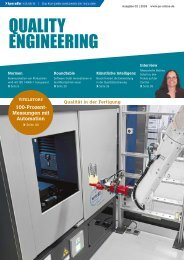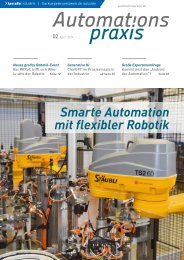cpp - Process technology for the chemical industry 02.2018
Create successful ePaper yourself
Turn your PDF publications into a flip-book with our unique Google optimized e-Paper software.
Unity copes with diversity<br />
As Bigvand emphasises, “Our customers’<br />
challenges clearly show that only unity can<br />
cope with diversity”. This is ensured by EB’s<br />
unified plant data model. All core disciplines,<br />
from basic engineering with FEED up to<br />
<strong>the</strong> pre-commissioning cause & effect<br />
check, use it jointly, in parallel and even<br />
simultaneously. They can base <strong>the</strong>ir specifications<br />
directly on <strong>the</strong> in<strong>for</strong>mation that colleagues<br />
from o<strong>the</strong>r departments have just<br />
created, because <strong>the</strong>y see it immediately<br />
with no need <strong>for</strong> data transfers and interfaces<br />
or <strong>for</strong> synchronisation.<br />
It is also much easier to integrate simulation,<br />
ERP or 3D systems, <strong>for</strong> instance, if<br />
unity exists. A web connection <strong>for</strong> cloud<br />
and app engineering additionally facilitates<br />
worldwide collaboration and makes it more<br />
flexible.<br />
The universal model in EB represents <strong>the</strong> basis <strong>for</strong> all core disciplines of plant<br />
engineering and communication with complementary systems<br />
From FEED to operation<br />
Seamlessness starts with <strong>the</strong> FEED phase. It<br />
initially benefits from EB’s openness and<br />
automatically imports <strong>the</strong> results from <strong>the</strong><br />
simulation, <strong>for</strong> example with Aspen or Etap.<br />
PFDs and worksheets immediately take over<br />
<strong>the</strong> calculations: EB 2018 shows all consequences<br />
of a particular scenario from <strong>the</strong><br />
rough flow diagram to <strong>the</strong> material balance<br />
– automatically and in separate documents.<br />
The process design <strong>the</strong>n “simply” has to add<br />
its specifications to <strong>the</strong> FEED scenario that is<br />
ultimately commissioned. The P&ID represents<br />
<strong>the</strong> collaborative core of all relevant<br />
disciplines and its definitions are <strong>the</strong> starting<br />
point <strong>for</strong> all fur<strong>the</strong>r elaborations. “That’s<br />
one more reason to allow all areas to access<br />
this data directly”, Bigvand comments. EB<br />
speeds up <strong>the</strong> creation of <strong>the</strong> flow diagram,<br />
amongst o<strong>the</strong>r things, with a pipe class-specific<br />
workflow and rule-based engineering.<br />
This ensures, <strong>for</strong> example, that <strong>the</strong> entire<br />
equipment assigned to a particular pipe is<br />
automatically adapted to <strong>the</strong> specifications<br />
<strong>for</strong> <strong>the</strong> pipe class concerned, <strong>for</strong> which TÜV<br />
certification is also available on request.<br />
Central means consistent<br />
A plant is thoroughly tested with <strong>the</strong> help<br />
of cause and effect documents prior to<br />
commissioning. According to Bigvand, this<br />
phase once again benefits especially from<br />
EB’s versatile data model. C&E tables which<br />
are absolutely reliable are key here. Up to<br />
now, <strong>the</strong>y have been created by compiling<br />
in<strong>for</strong>mation from different sources and different<br />
disciplines, <strong>for</strong> example from P&IDs,<br />
logic diagrams or o<strong>the</strong>r documents. Several<br />
highly qualified experts spend weeks on this<br />
task every time. EB, on <strong>the</strong> o<strong>the</strong>r hand,<br />
extracts all necessary in<strong>for</strong>mation from its<br />
central data source and automatically creates<br />
<strong>the</strong> report matrix. This ensures unprecedented<br />
consistency and frees up important<br />
engineering capacity.<br />
The plat<strong>for</strong>m’s seamlessness continues with<br />
support <strong>for</strong> plant operation, firstly with<br />
web-based maintenance functions in <strong>the</strong><br />
<strong>for</strong>m of apps and secondly with special<br />
execution management <strong>for</strong> major conversion<br />
and expansion projects. This also works<br />
with subcontractors or on multiple contract<br />
levels. EB 2018 additionally ensures that <strong>the</strong><br />
new data is restored to <strong>the</strong> updated “as is”<br />
status in an orderly and consistent way.<br />
All relevant objects are united in a single<br />
model<br />
Advanced change management<br />
At <strong>the</strong> same time, a uni<strong>for</strong>m data model of<br />
<strong>the</strong> plant means significantly more efficiency<br />
in <strong>the</strong> event of changes. With EB, if desired,<br />
every change in every discipline directly<br />
affects all representations of <strong>the</strong><br />
changed object in graphics, tables or Explorer<br />
and is visible to all areas. “However,<br />
parallel editing of <strong>the</strong> model by different<br />
experts and departments calls <strong>for</strong> advanced<br />
change management”, Bigvand stresses. According<br />
to him, <strong>the</strong> plat<strong>for</strong>m meets this<br />
requirement with a whole host of functions<br />
including a detailed, individually configurable<br />
history log <strong>for</strong> each individual object<br />
as well as particularly transparent revision<br />
and version management. Fur<strong>the</strong>rmore, EB<br />
provides recommendations <strong>for</strong> attributes,<br />
thus enabling change requests to be checked<br />
be<strong>for</strong>e <strong>the</strong>y are implemented.<br />
“The seamlessness and consistency of this<br />
solution result in a completely new level of<br />
efficiency, while also ensuring that it is future-proof<br />
in <strong>the</strong> sense of smart factories<br />
and Industry 4.0. The combination of parallelised<br />
tasks, central data and openness to<br />
complementary tools sets a new benchmark”,<br />
board member Vogt concludes.<br />
www.<strong>cpp</strong>-net.com<br />
Online search: <strong>cpp</strong>0218aucotec<br />
Hall 9.2, Booth B12<br />
AUTHOR:<br />
JOHANNA KIESEL<br />
Press and Public Relations,<br />
Aucotec<br />
<strong>cpp</strong> 02-2018 13


